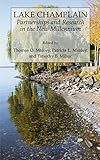Lake champlain: partnerships and research in the new millennium [Libro electrónico] / edited by Thomas O. Manley, Patricia L. Manley, Timothy B. Mihuc
Manley, Thomas O [editor] | Manley, Patricia L [editor/a] | Mihuc, Timothy B [editor/a].
Tipo de material: Libro
en línea Editor: New York, New York, United States: Kluwer Academic/Plenum Publishers, c2004Descripción: ix, 411 páginas : ilustraciones mapas ; 26 centímetros.ISBN: 0306484692; 9781441934499 (Print); 9781475740806 (Online).Tema(s): Lake ecology -- Research -- Champlain, Lake -- CongressesDescriptor(es) geográficos: Champlain, Lake -- Environmental conditions -- Research -- CongressesNota de acceso: Disponible para usuarios de ECOSUR con su clave de acceso Nota de bibliografía: Incluye bibliografía e índice: páginas 405-411 Número de sistema: 55557Contenidos:Mostrar
Resumen:
Libro
en línea Editor: New York, New York, United States: Kluwer Academic/Plenum Publishers, c2004Descripción: ix, 411 páginas : ilustraciones mapas ; 26 centímetros.ISBN: 0306484692; 9781441934499 (Print); 9781475740806 (Online).Tema(s): Lake ecology -- Research -- Champlain, Lake -- CongressesDescriptor(es) geográficos: Champlain, Lake -- Environmental conditions -- Research -- CongressesNota de acceso: Disponible para usuarios de ECOSUR con su clave de acceso Nota de bibliografía: Incluye bibliografía e índice: páginas 405-411 Número de sistema: 55557Contenidos:Mostrar
Resumen:| Tipo de ítem | Biblioteca actual | Colección | Signatura | Estado | Fecha de vencimiento | Código de barras |
|---|---|---|---|---|---|---|
| Libros | Biblioteca Electrónica Recursos en línea (RE) | Acervo General | Recurso digital | ECO400555574072 |
Incluye bibliografía e índice: páginas 405-411
1. Missisquoi bay - an international partnership towards restoration.. 2. Reflections on the relationships between scientific research and a watershed approach to water management: the case of the missisquoi bay watershed corporation.. 3. A preliminary investigation into the possible emission sources for atmospheric mercury found in the lake Champlain basin.. 4. Effectiveness of agricultural best management practices in reducing phosphorous loading to lake Champlain.. 5. Zebra mussel monitoring in the Richelieu river: a fruitful interaction between scientific research and public involvement.. 6. Water quality improvements following riparian restoration in two Vermont agricultural watersheds.. 7. Temporal and spatial variability in non-point source phosphorus in relation to agricultural production and terrestrial indicators: the beaver brook case study, pike river basin, Québec.. 8. A benefit-cost framework to evaluate the impact of legislation supporting reduction of agricultural pollution at the watershed level.. 9. Importance of hydric soils and near-lake areas as phosphorus source areas in the lake Champlain basin: evidence from a landscape-level model.. 10. Using a landscape approach to interpret diffuse phosphorus pollution and assist with water quality management in the basins of lake Champlain (Vermont and lac léman (France.. 11. Status and trends of phosphorus in lake Champlain and its tributaries, 1990-2000.. 12. A landscape scale evaluation of phosphorus retention in wetlands of the laplatte river basin, Vermont, USA.. 13. The occurrence of cyanobacterial toxins in lake Champlain.. 14. Where have all the rotifers gone? Zooplankton community patterns in lake Champlain from 1992-2001.. 15. Use of GIS and remote sensing to develop indicators of phosphorus non-point source pollution in the pike river basin..
16. Influence of substrate composition on distribution of eastern sand darters (ammocrypta pellucida in the Poultney river.. 17. Lakebed pockmarks in Burlington bay, lake Champlain: I. Hydrodynamics and implications of origin.. 18. Lakebed pockmarks in Burlington bay, Lake Champlain II. Habitat characteristics and biological patterns.. 19. Hydrodynamics of the south main lake and south lake, lake Champlain.. 20. A review of vorticity waves in lakes.. Index
Disponible para usuarios de ECOSUR con su clave de acceso
The primary purpose of this proceedings is to look at a common body of water shared by Canada and the US and to summarize knowledge about the dynamics of this system with a primary focus of land use, water management, and bridging the gap between researchers and the public. From the preface: Lake Champlain spans two states, Vermont and New York, as well as two nations, the United States of America and Canada. Such a large body of water facing a wide variety of environmental stresses cannot be put on the path of restoration without the concerted efforts of motivated stakeholders. In order to be effective, however, these stakeholders must not only be dedicated to their own goals, but more importantly, be aware of, fully understand, and support the efforts of a myriad of other goals brought to the table by other dedicated groups. While easier said than done, Lake Champlain has and will continue to benefit from the cooperation and partnerships spanning international to local venues. This monograph represents the result of one of many partnerships between the United States and Canada; specifically the 2002 Spring Symposium sponsored by the Lake Champlain Research Consortium that was hosted by the Missisquoi Bay Watershed Corporation (Corporation Bassin Versant Baie Missisquoi) at the Fort Saint-Jean Campus, May 20-23, 2002. The focus of this meeting was to bring together a wide variety of stakeholders to not only learn about new developments and research in the basin, but to forge new and stronger bonds for future cooperation and management of this truly great lake. eng
Disponible en línea
Disponible en formato PDF
Subscripción a ELSEVIER 26 de diciembre del 2013
